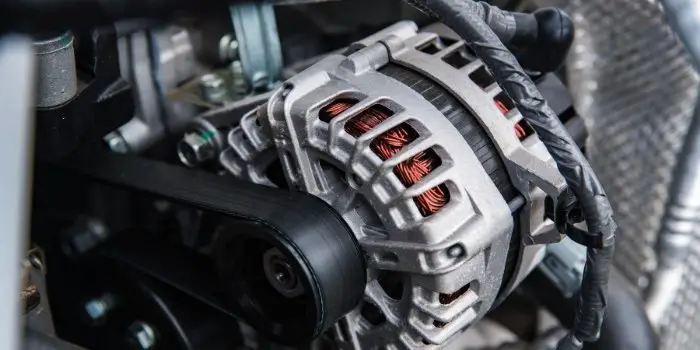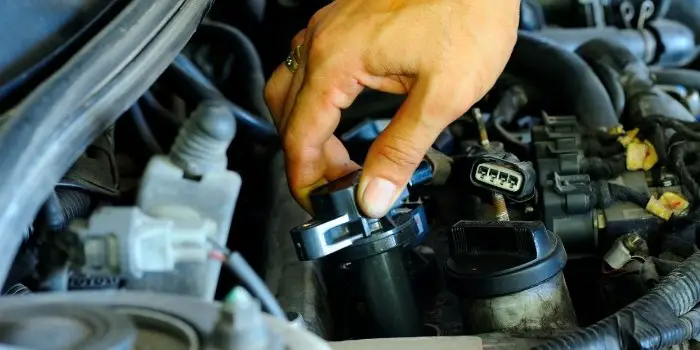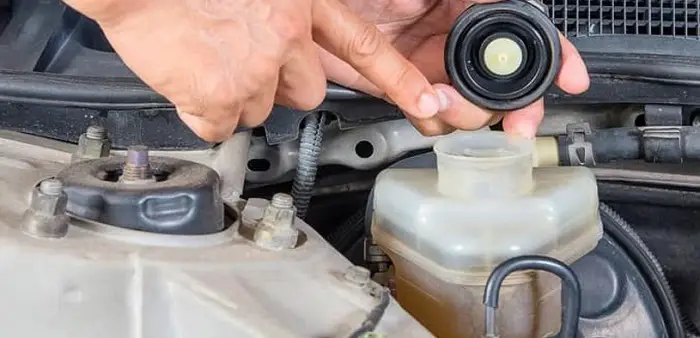
A belt tensioner is a device that keeps the engine belts tight and in proper alignment. The tensioner applies the correct amount of tension to the belts so they can do their job properly.
If the tensioner isn’t working, the belts can slip or break, which can cause serious engine damage.
Driving with a defective belt tensioner is not safe when it comes to avoiding early wear or irreversible damage to the accessory pulleys.
A faulty or worn belt tensioner can no longer fulfill its primary function of providing adequate tension to allow the belt to spin the AC compressor pulley, power steering pump pulley, alternator pulley, and other pulleys.
When the belt tensioner wears down, the belt may begin to slide, causing excessive heat, cause noise, and a reduction in accessory performance.
This implies that your alternator will no longer be able to recharge your battery at full capacity.
The efficiency of your AC compressor will drop considerably, as will the performance of your power steering.
Table of Contents
Failure Modes of Belt Tensioners
The tension of the belt is critical to the effective operation of the auxiliary belt drive system.
The major duty of the belt tensioner is to transmit torque to operate the accessories, and anything that interferes with that transfer is an issue.
Historically, most of the attention of torque transfer failure has been on the belt itself, whereas in reality, belt tension is to blame.
The following are the five most prevalent belt tensioner failure modes:
1. Slip of the Belt
If your belt tensioner is worn, it might cause the belt to slide at the accessories, resulting in screeching noises, excessive heat at the accessory pulleys, and decreased accessory performance.
This might permanently harm the belt and its components.
2. Misalignment of the belt
All of the pulleys should be in alignment as the belt goes through the auxiliary belt drive system.
Over a hundred thousand miles, a tensioner will cycle a billion times, causing the tensioner pivot bushing to deteriorate.
When the pivot bushing wears out, the tensioner arm might become misaligned.
As a result, the belt runs uphill on the pulley, destroying it and making a lot of noise.
Only one degree of misalignment is tolerated by the mechanism.
Each degree over that generates thirty degrees of heat for the belt and accessory bearings, resulting in accessory failure.
3. The Tension Damper Failed
The damping mechanism is essential for regulating vibration and power fluctuations.
When the damper is worn, it can no longer reduce the tension or arm movement that causes the belt to slap against the following item.
The item will eventually fail prematurely.
4. Belt Wearing and Mating
It stands to reason that the belt and pulley must be correctly mated to generate the required friction to ensure effective accessory performance.
Normal wear causes the belt to lose material.
With just 5% belt wear, the belt will not match well with the pulley, which will lose traction in the ridges.
Instead of delivering power, the belt just wanders and slips over the top of the pulley.
As the belt wears, the evacuation channel expands, enabling water to enter between the pulley and the belt, pulling up on the belt and causing it to hydroplane on the pulley.
5. Alternator Belt Slip
Each accessory powered by the ABDS has its function and is dependent on a smooth and consistent supply of driving power.
When the ABD system is functioning correctly, all accessories operate as they should.
For example, the alternator will be spinning at the specified speed, producing energy to operate the car and replenish the battery.
As the belt slides, the output of all the attachments decreases. With a belt clip, the quantity of power generated by the alternator, for example, will vary.
This may cause the driver to believe that they have a faulty battery or alternator when, in fact, the issue is a worn belt or tensioner.
The check engine light may even illuminate in conjunction with an unrelated fault code.
The accessories are ineffective, and the extra load exerted on them will decrease their life.
As you can see, a worn tensioner may have serious consequences, it is up to you to determine if it’s safe for you to drive with a faulty belt tensioner.
Identifying tensioner problems takes more than a basic belt examination.
Also, keep in mind that the tensioner has the same service life as the belt. They should be swapped out together.
The Most Common Signs of a Faulty Belt Tensioner
When the tensioner begins to fail, it will create a loud, growling noise.
This indicates that the bearing within the tensioner is deteriorating and will soon come apart.
When the tensioner fails, the pulley may also fall out of position. So, if you hear a growling sound, replace the tensioner.
A few other most common signs include…
a. Serpentine belt dislodges during starting
If the serpentine belt comes loose after starting or running the engine, it signifies the belt tensioner is no longer exerting tension to hold the serpentine belt in place.
Check the belt tensioner and pulley while the engine is turned off.
b. Hydraulic tensioner failure
A well-functioning hydraulic tensioner can apply a significant amount of tension. When a leak occurs, the tensioner is unable to deliver the required tension to the belt.
Examine the tensioner for oil leaks. If there is a leak, the tensioner should be replaced.
c. Serpentine belt deterioration that is quick or uneven
For the serpentine belt to fit correctly on each rotating pulley groove, such as the AC compressor, power steering pump, alternator, and others, appropriate belt tension is required.
When the tension is too loose, the belt will leap out of position and rest unevenly on the grooves.
As a result, the serpentine belt will quickly wear down and finally fall out of position.
d. Power outage with the battery light lit
The serpentine belt will slide and break if the tensioner fails. When this occurs, the power steering pump, the alternator, and the air conditioner compressor all shut off.
Because there is no belt rotating the pulley, the battery light will illuminate, making steering difficult.
The AC compressor will also cease to function.
Can You Replace a Faulty Belt Tensioner, or Do You Need a Mechanic?
It’s possible to replace a belt tensioner yourself, but it’s not an easy job.
You’ll need to have some experience with engine repairs and be comfortable working on your car.
If you’re not confident in your abilities, it’s best to take your car to a mechanic.
The cost of changing a belt tensioner varies depending on the make and model of your car.
It’s typically a fairly inexpensive repair, but the exact cost will depend on the parts and labor required.
The job itself shouldn’t take more than a few hours.
Final Thoughts
Driving with a faulty belt tensioner can be dangerous since the tensioner provides enough tension to power accessories.
Wear and tear on it will ultimately cause it to slide, make loud noises, and produce a great extent of heat.
It also reduces accessory performance, and this decline in performance will ultimately result in long-term accessory damage.
It also causes excessive noise; when it’s wet outdoors, it will be excruciatingly loud and irritating.

Based in Orem (Utah) John Paterson graduated from Utah Valley University and has begun writing in 2009. He has a large wealth of experience in writing articles related to cars, automotive repair, wheels, cleaning/maintenance, and much more. He has also written instructional articles in a similar niche for a few online publications as well. Currently, he works as a mechanic in his personal garage shop where he loves serving his countrymen from his heart.





